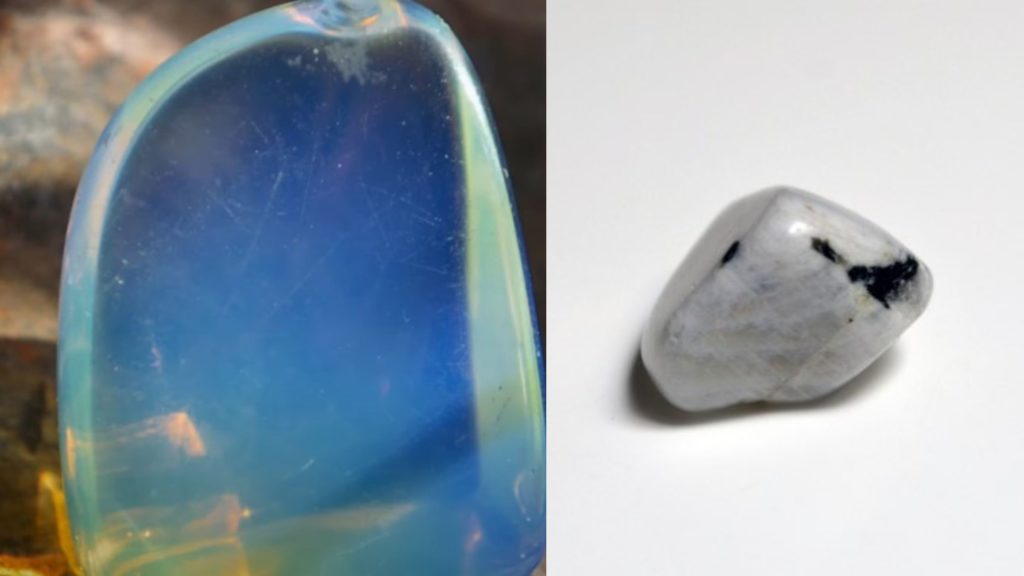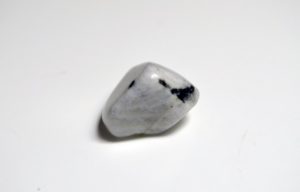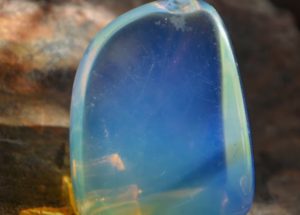Last Updated on January 2, 2024 by IncenseJunction
In the world of gemstones, there are two captivating options that often intrigue and mesmerize individuals: moonstone and opalite. These two gemstones possess ethereal beauty and a mystical aura that makes them highly sought after in the realm of jewelry and crystal enthusiasts. However, despite their shared allure, moonstone and opalite are distinct gemstones with unique characteristics.
In this comprehensive article, we aim to uncover the similarities and differences between moonstone and opalite, shedding light on their individual traits, properties, and origins.
Moonstone: A Glimpse into Its Enigmatic Nature
Origin and Appearance
Moonstone, an enchanting gemstone, derives its name from the mesmerizing play of light that resembles the moon’s ethereal glow. It belongs to the feldspar mineral group and is predominantly composed of orthoclase or albite. Moonstones are commonly found in countries like Sri Lanka, India, Madagascar, and Myanmar.
In terms of appearance, moonstone showcases a range of captivating colors, including milky white, bluish-white, peach, and gray. This gemstone is renowned for its adularescence, a captivating phenomenon where a bluish-white sheen glides across its surface, reminiscent of moonlight passing through a veil of clouds.
Metaphysical Properties
Beyond its captivating appearance, moonstone holds various metaphysical properties that have fascinated many throughout history. It is often associated with feminine energy, intuition, and balance. Moonstone is believed to enhance emotional well-being, promote inner harmony, and foster spiritual growth. Many individuals turn to moonstone for its calming and soothing effects, as it is believed to alleviate stress and anxiety while fostering emotional healing.
Uses and Symbolism
Moonstone’s allure extends beyond its metaphysical properties. In the realm of jewelry, moonstone is highly prized for its captivating iridescence, making it a popular choice for pendants, earrings, rings, and bracelets. Additionally, moonstone has been used in various cultural and spiritual practices, symbolizing purity, love, and fertility.
Opalite: Unveiling Its Translucent Beauty
Origin and Composition
Opalite, also known as Opalized Glass, is a man-made gemstone crafted from glass and infused with opalescent properties. It is a popular choice for jewelry due to its mesmerizing, translucent appearance, which mirrors the captivating play of colors seen in natural opals.
Appearance and Characteristics
Opalite possesses a unique iridescent glow that ranges from milky white to pale blue, often resembling the ethereal beauty of moonstone. Its opalescent sheen captivates onlookers with an otherworldly shimmer, making it a popular gemstone for jewelry and decorative pieces.
Metaphysical Properties and Symbolism
Metaphysically, opalite is believed to possess calming and soothing properties, similar to moonstone. It is associated with emotional healing, serenity, and communication. Opalite is often used to balance energy, enhance spiritual connections, and foster clarity of thought. Many individuals seek opalite as a symbol of transition and personal growth, as it is believed to facilitate positive transformations.
Differentiating Moonstone and Opalite
While moonstone and opalite share some similarities in appearance and metaphysical properties, it is crucial to recognize their distinctive features to appreciate their individual beauty fully.
- Composition: Moonstone is a naturally occurring gemstone composed of feldspar minerals, while opalite is a man-made gemstone crafted from glass infused with opalescent properties.
- Origin: Moonstone is found in various countries worldwide, including Sri Lanka, India, and Madagascar. Opalite, being a man-made gemstone, does not have a specific geographic origin.
- Color Variations: Moonstone exhibits a broader range of colors, including white, bluish-white, peach, and gray. Opalite, on the other hand, is predominantly milky white to pale blue, resembling the ethereal beauty of moonstone.
- Adularescence: Moonstone is renowned for its adularescence, a captivating phenomenon where a bluish-white sheen glides across its surface. Opalite, while possessing a similar iridescent quality, lacks the distinct adularescence seen in moonstone.
Also, read:
Conclusion
Moonstone and opalite are captivating gemstones that offer unique beauty and metaphysical properties. While moonstone boasts a natural origin and an enchanting adularescent sheen, opalite mesmerizes with its translucent opalescence. Understanding the similarities and differences between these gemstones allows us to appreciate their individual allure and make informed choices when selecting jewelry or crystals for spiritual practices.




